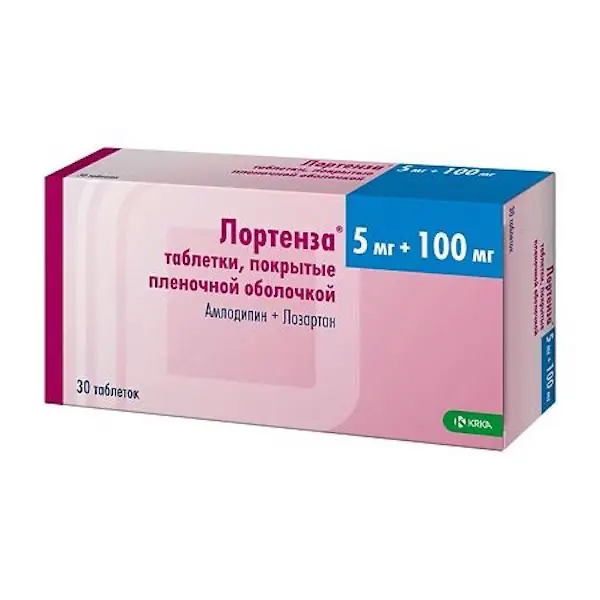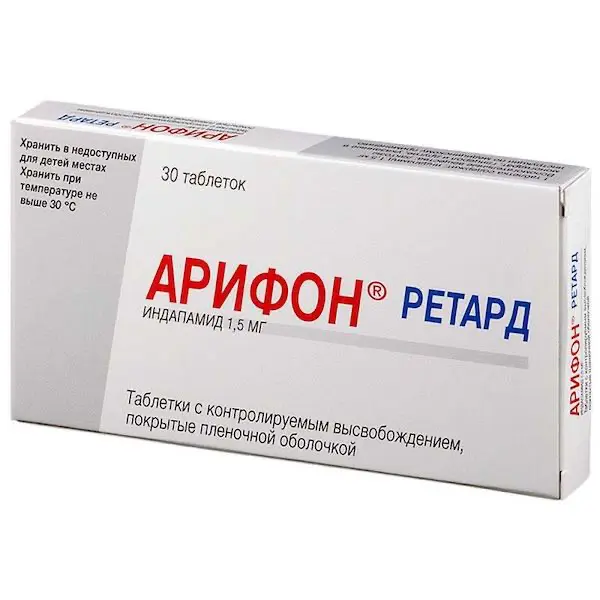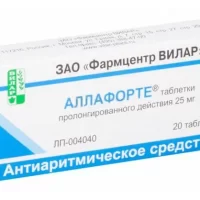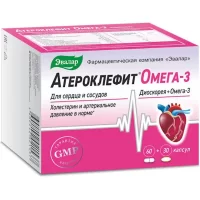Description
Lortenza Pharmacodynamics
The drug Lortenza is a combination of two active components with complementary antihypertensive effect: amlodipine (blocker of “slow” calcium channels (SMCB)) and losartan (angiotensin II receptor antagonist (ARA II)). Active components of drug have different mechanism of antihypertensive action: amlodipine causes vasodilation, reducing total peripheral vascular resistance (TPR), losartan affects renin-angiotensin-aldosterone system (RAAS) (inhibits angiotensin II effects), which leads to a more significant reduction of blood pressure (BP) compared to that during monotherapy with each drug.
Amlodipine
Amlodipine is a dihydropyridine derivative that blocks “slow” calcium channels and reduces transmembrane flow of calcium ions into cardiomyocytes and vascular smooth muscle cells. The antihypertensive effect of amlodipine is associated with a direct relaxing effect on arterial vascular smooth muscle. In preclinical studies amlodipine had a more pronounced effect on vascular smooth muscle cells compared to cardiomyocytes. Amlodipine has no adverse effect on either atrioventricular conduction or myocardial contractility. It reduces renal vascular resistance and increases renal blood flow. Studies of amlodipine in patients with chronic heart failure (CHF) of functional class II-IV according to NYHA classification (classification of New York Heart Association) have shown that amlodipine has no adverse effect on exercise tolerance, ejection fraction or plasma lipid and glucose concentrations. After a single oral administration of amlodipine, the action begins in 2-4 hours and lasts for 24 hours.
Maximum antihypertensive effect is achieved not earlier than 4 weeks after the start of therapy. Amlodipine reduces BP in patients in “lying” and “sitting” position, as well as during physical activity. Due to gradual development of pharmacodynamic effect amlodipine does not cause a sharp decrease in BP or reflex tachycardia. Amlodipine reduces the severity of left ventricular hypertrophy. Hemodynamic effects remain unchanged with long-term use of amlodipine.
Lozartan
Losartan is a synthetic ARA II (type AT1) for oral administration. Angiotensin II is a potent vasoconstrictor, the main active hormone of the RAAS and an important determinant of the pathophysiology of arterial hypertension (AH). Angiotensin II binds to ATi-receptors present in many tissues (vascular smooth muscle tissue, adrenal glands, kidneys, and heart) and performs important biological functions, including vasoconstriction and aldosterone release. Angiotensin II also stimulates vascular smooth muscle cell proliferation. Losartan selectively blocks ATi-receptors. Losartan and its pharmacologically active carboxylated metabolite (E-3174) both in vitro and in vivo block all physiological effects of angiotensin II regardless of its source or synthesis pathway.
Losartan has no agonist properties and does not block the receptors of other hormones or ion channels involved in cardiovascular regulation. Losartan does not inhibit angiotensin-converting enzyme (ACE) degrading bradykinin. Accordingly, it does not cause an increase in the frequency of bradykinin-mediated adverse effects.
The inhibition of angiotensin II-induced regulation of renin secretion by the “negative” feedback mechanism of losartan treatment causes an increase in plasma renin activity (PRA), which leads to an increase in plasma angiotensin II concentrations. However, the antihypertensive effect and decreased plasma aldosterone concentration persist, indicating effective blockade of AT1 receptors. After discontinuation of losartan, blood ARP and plasma angiotensin II concentrations decrease within 3 days to baseline values.
Indications
Arterial hypertension (patients who are indicated for combination therapy with amlodipine and losartan).
Contraindications
Hypersensitivity to the active substances and/or excipients of the drug.
-Pregnancy and breastfeeding (see section “Administration during pregnancy and breastfeeding”).
-Severe hepatic failure (more than 9 points on the Child-Pugh scale).
-Obstruction of the left ventricular outflow tract (e.g., hemodynamically significant aortic stenosis).
-Hemodynamically unstable heart failure after acute myocardial infarction.
-Shock (including cardiogenic shock).
-Age before 18 years of age (efficacy and safety not established).
-Severe arterial hypotension (systolic BP less than 90 mm Hg).
-Severe renal dysfunction (CKD less than 20 ml/min), use in patients on hemodialysis.
Simultaneous use with aliskiren or aliskiren-containing drugs in patients with diabetes and/or impaired renal function (glomerular filtration rate (GFR) less than 60 ml/min/1.73 m).
-Lactose intolerance, lactase deficiency, glucose-galactose malabsorption syndrome.
Dosage and administration
- Orally, once a day, regardless of the time of the meal, with a little water.
- The recommended dose of the drug Lortenza is 1 tablet per day.
- Lortenza 5 mg + 50 mg is recommended for patients who have not achieved an adequate BP control while taking amlodipine 5 mg or losartan 50 mg in monotherapy.
- Lortenza 5 mg + 100 mg is indicated for patients who have not achieved adequate BP control with lozartan 100 mg or Lortenza 5 mg + 50 mg.
- Lortenza 10 mg + 50 mg is indicated for patients who have not achieved adequate BP control with amlodipine 10 mg or Lortenza 5 mg + 50 mg.
- Lortenza 10 mg + 100 mg is administered to patients who have not achieved adequate BP control when using Lortenza 5 mg + 100 mg or 10 mg + 50 mg.
- The dose is adjusted after previously performed titration of doses of individual components of the drug. If it is necessary to change the dose of one of the active substances in the fixed combination preparation (e.g., due to newly diagnosed disease, change in the patient’s condition or drug interaction), individual selection of doses of individual components is required. Maximum daily dose is 10 mg + 100 mg.
- Patients taking losartan and amlodipine concomitantly may be switched to Lortenza containing losartan and amlodipine in the same doses.
- Impaired renal function
No dose adjustment is required for CKD of 50 to 20 mL/min.
Lortenza is contraindicated in patients with a CK of less than 20 ml/min and in patients on hemodialysis (see section “Contraindications”). - Patients with decreased CBC
In patients with reduced blood circulatory capacity (e.g. due to treatment with high doses of diuretics, etc.), the starting dose of losartan should be reduced to 25 mg once daily.
Since Lortenza is not available in doses containing 25 mg of losartan, this dose should be administered in losartan monotherapy.
Before using Lortenza, the blood circulation and plasma sodium content should be restored. - Impaired hepatic function
Patients with a history of impaired liver function (less than 9 points on the Child-Pugh scale) are recommended to use lower doses of losartan. Due to the lack of a 25 mg dose of Lortenza, this dose should be administered in losartan monotherapy.
Lortenza may be used in patients with hepatic impairment (less than 9 points on the Child-Pugh scale) who are recommended to take losartan at a dose of 50 mg at the discretion of their physician. - Elderly patients
In elderly patients (over 65 years of age) due to reduced clearance, it is recommended to start amlodipine therapy with a dose of 2.5 mg once daily. Since the drug Lortenza has no dosage containing 2.5 mg amlodipine, this dose should be started in amlodipine monotherapy. - Children and adolescents
Lortenza should not be administered to children and adolescents younger than 18 years of age, because there are no data about the effectiveness and safety in this group of patients.





